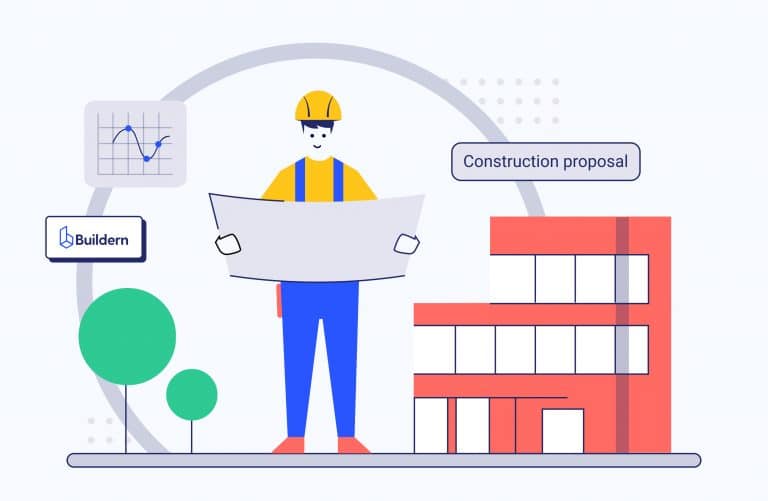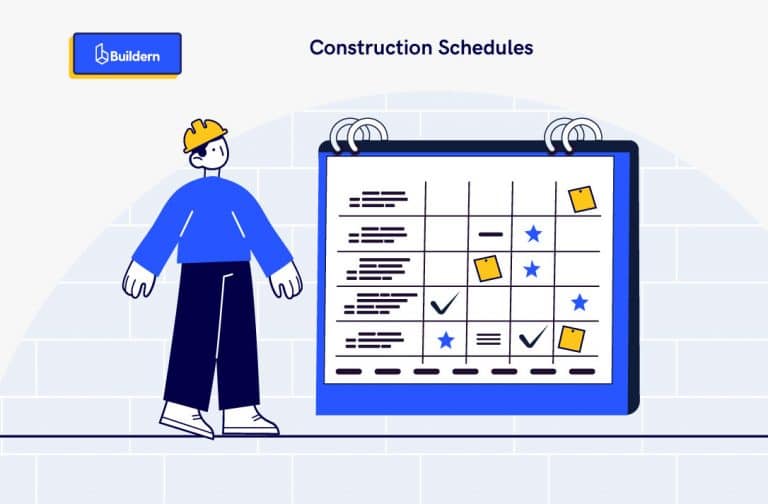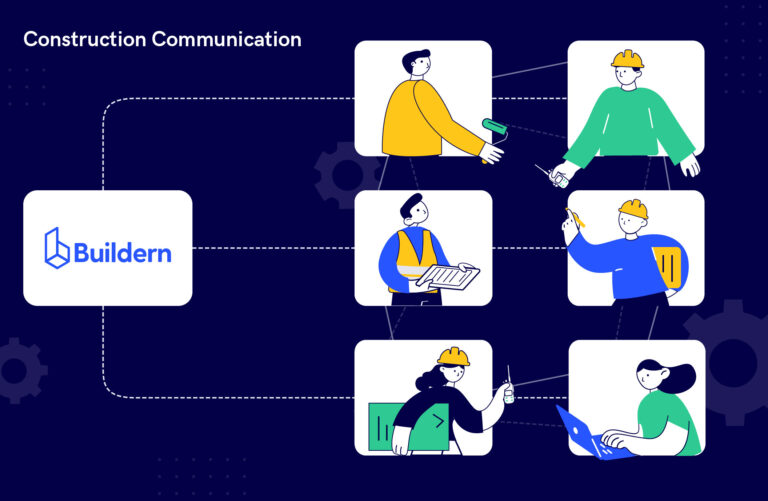Construction Allowances 101: 4 Effective Practices for Budget Management

One of the most desired situations for any builder is to have an estimated budget as close to the true cost as possible. The more accurate the planned budget, the easier and faster project completion will be. However, the construction industry is all about uncertainties and unexpected things popping up during the project. So, it’s important to be flexible to be able to mitigate possible variations. And that’s what construction allowances are for!
They provide breathing room for the budget and help you be prepared for some unplanned costs that are not always possible to estimate in detail at the beginning of the project.
This article discusses construction allowances, the key way to treat them, and some crucial factors to consider to improve project cost predictability.
Ready to start? So are we!

Introduction to Construction Allowances
In construction, an allowance is an amount included in the contract for a certain material or service, the details of which, such as price, quantities, etc., are not yet determined when signing a contract.
To put it more simply, it is the average price for yet-to-be-determined selections until a more accurate price can be obtained during the project.
Construction allowances help one understand the total project costs, i.e. better, set a budget at the early stages of the project, even before all of the construction selections.
PRO TIP: Here are construction budgeting phases to get a better idea about planning.
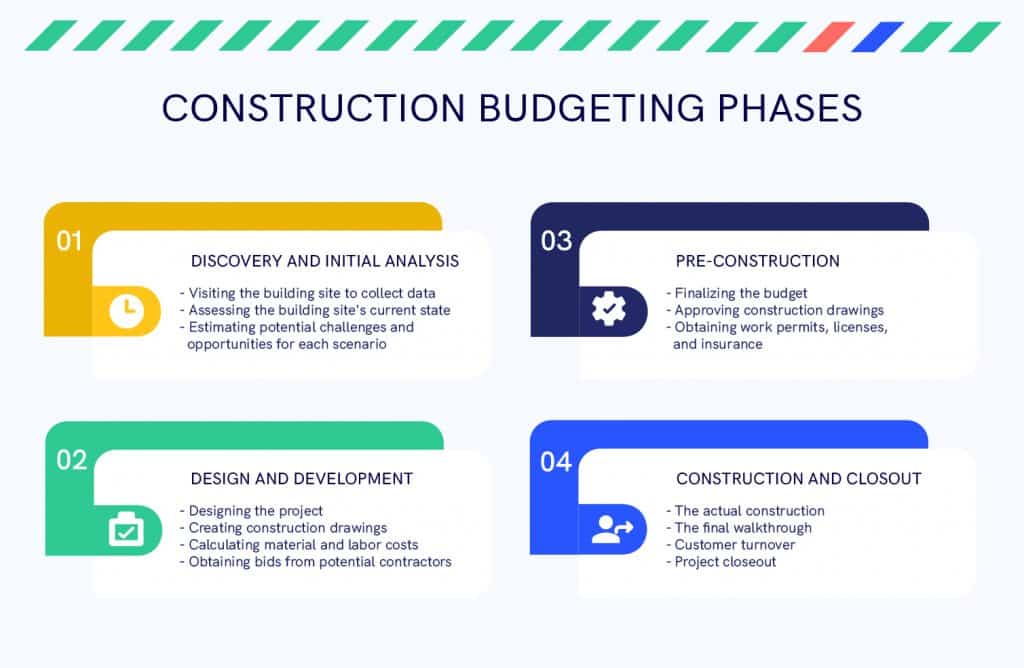
Afterward, as the project moves on and the prices of specific selections are clear, the final cost of the project is determined. If the cost exceeds the allowance, it will increase the contract’s total price. In the opposite case, the project’s total cost will decrease, and the contractor must return the difference to the client.
Now, let’s look at the main types of allowances and where they come in handy.
Types of Construction Allowances
In general, there are two types of construction allowances: materials allowances and installation allowances.
Material Allowances
Material allowances are used to permit flexibility in materials selection, such as the selection of finishes, flooring, lighting, or plumbing fixtures. As a rule, such allowances fluctuate based on the owner’s decisions and choices.
For example, the owner can hesitate between two materials for the future building; flooring and carpet. If the client hasn’t chosen the final material when estimating a budget, then the contractor can not determine the project’s final price. Therefore, it might be reasonable to establish an allowance for the material.
It’s important to note that material allowances cover only the cost of the material itself. They don’t include the cost of labor to unload or install the material.
Installation Allowances
Installation allowances are used for scopes of work that cannot be quantified until the work is performed.
One example of installation allowance is building a custom home without testing the soil at the construction site. In that case, a builder can’t estimate the costs of laying a home’s foundation, as they don’t know whether the ground is all rocky and will need detailed preparation for the foundation or the ground is already clear and grabbed and does not need extra work.
Installation allowances help to cover this and similar uncertainties.
Factors That Affect Construction Allowances
Let’s look at the main factors you should consider during construction estimation.
Location and Site Conditions
The unexpectedly revealed site conditions of the future building can significantly affect the estimation. Therefore, conducting a thorough site investigation and examining the site conditions beforehand can help to provide a more accurate estimate.
Waterlogged soils, the nature of the rock, and similar factors can affect the estimated materials and labor, delay the issuance of permits, and increase the time needed to complete the project.
The location of the construction site is also crucial. If it’s far from facilities and construction suppliers, you should consider the added cost of transportation.
Size and Scope of the Project
According to research, the scale and scope of the project and its complexity rank as the most important factors influencing the project cost.
In construction, project scale and complexity can be viewed in terms of:
- Size of a task
- The technical complexity of the project
- Resource requirements
- The speed of production
- The site layout
- The unpredictability of work and site construction
These points have a great influence on resourcing a project and the expected project duration and, consequently, in determining the construction cost.
Building Codes and Regulations
Construction projects must conform to the regional codes and regulations to obtain a building permit – an approval needed for construction, usually from a local council.
The costs of approvals from regulatory agencies may vary depending on where the construction site is. Examples of regulatory requirements include pollution control and emission compliance.
Selection of Materials and Finish
And, of course, it’s key to take note of the type and quality of material that the allowance should cover.
Imagine budgeting your work for linoleum, but the owner eventually chooses tile floors instead. As a result, it will cause a huge cost difference.
Even if there may not be a large gap between the prices of different types of materials, material selection can also affect the scope of work and the level of skill, experience or time needed to complete the work.
Also, as the prices of the materials are always changing, make sure to include the updated prices in the construction estimations. Having your finger on the pricing changes will help adjust the budget accordingly if needed.
Tips for Effective Allowance Management
If used properly, allowances can be a very handy budgeting tool. When allocating and drafting allowances, here are some tried and tested tips to remember.
Include as Many Details as Possible
Well, allowance itself is a tool to deal with uncertainties. However, there may be details specific only for certain construction allowances. Clearly documenting these details can make allowances more manageable.
For example, if you include a material allowance for carpets, let your client know the allowance assumes carpeting at a certain price per/square yard, and they’ll need certain square yards. This will help both sides better understand the upcoming costs.
Use Realistic Prices
It’s essential to use realistic prices for the construction allowances so that they reflect the actual pricing of the market.
Even if the client is not sure about certain selections to determine their cost, construct your estimations on your previous similar experience.
Rely on industry average numbers based on experience with similar projects. You can also ask follow-up questions to the owner to know all possible details of the type and quality of the material or service needed. If doing it right, your estimates shouldn’t have more than 5-8 % of the variance.
Clearly Communicate the Essence of Allowances to the Client
Ensure to inform the client beforehand about allowances, how they work, and what happens when they run over or under a contract allowance amount. Let them know you’ll fix the differences between the estimated allowance and the price with change orders or invoice differences.
This will help avoid potential disputes when the construction contract price changes during the project.
Buildern in Action: How to Calculate Construction Allowance
As the project progresses, progressive bidding identifies the true costs of many estimated allowances. When more costs appear, you should ensure all members of the design and construction team and your client have proper information regarding that.
Doing that manually can become a nightmare, but with a unified information source with shared access for all your project stakeholders, the task will be easy to carry out. So, here’s what we suggest.

Buildern is a complete construction project management platform that lets you collect all information and cost updates for each project in a single database and invite all your project stakeholders to have timely updates on any project change occurring.
Here is a quick guide on how you can manage and keep a record of all the construction selections and allowances in the unified dashboard with the help of Buildern!
Buildern’s allowances section helps you break down costs into corresponding categories, like allowances for the kitchen, bedrooms, bathrooms, etc. With real-time information updates for all project participants, this software guarantees all stakeholders have access to project status and cost updates.

To create a new allowance, head to the “Estimate” section in your Buildern account (sign up or log in here), click on the “Add Item” button, type out the appropriate details, and Save. For one allowance, you can add innumerate selections, allowing you to present any item with a detailed description, internal notes, and other relevant information.
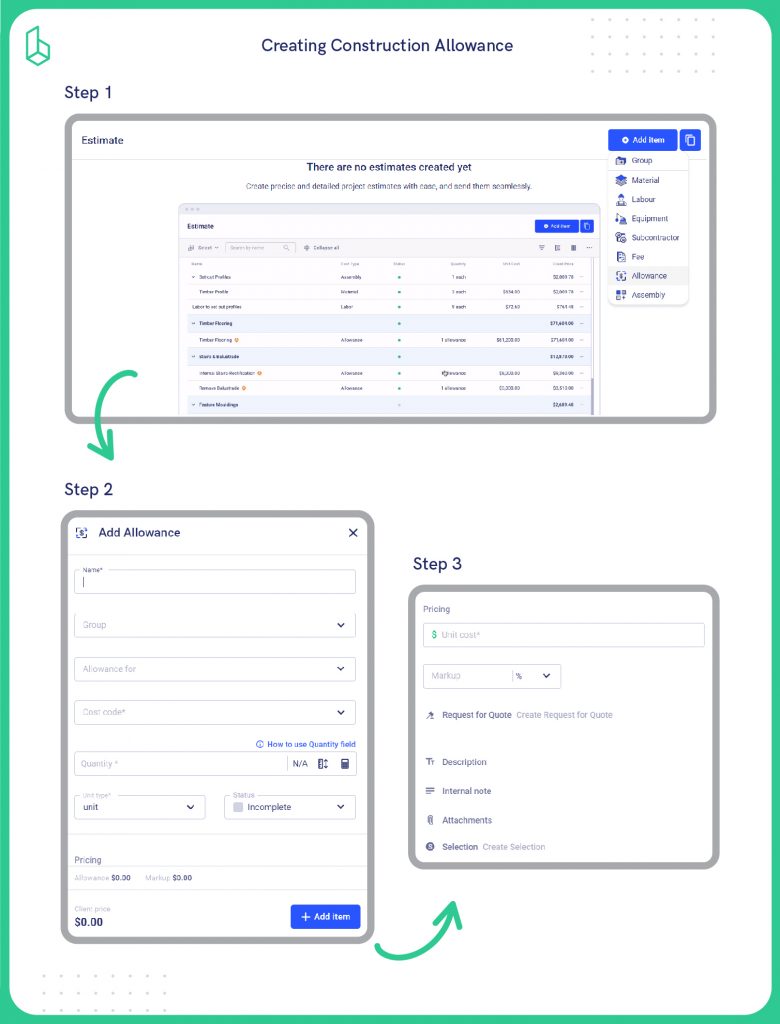
Once you have an allowance created through the Estimates, you can share it with the finalized proposal. The client will see the predefined types for each allowance, i.e., material, labour, equipment, etc.
The system will update all the changes in the original budget for better financial management. This way, you will always have an up-to-date view of your finances!

Wrapping up
All parties should define the construction budget early in the project life cycle, even if the requirements are incomplete. Construction allowances are there to smoothen this challenge and to give project stakeholders a general understanding of the project costs before all the details are clear. So, learning to work with allowances is your gateway to a more manageable construction process and better budget estimates.
Buildern’s feature for Allowances and Selections can be your trusted partner in managing construction allowances. Simply create allowances from the estimation, add any comments you need to communicate, and send them to your clients with selections directly from Buildern’s dashboard.




